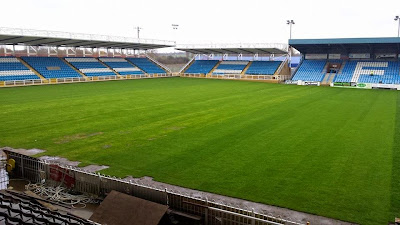 |
| Ben Kaye |
After
using Joe McLocklan (#905) and Jack Lee (#918) as his main hookers during his
first year in charge, Daryl Powell decided to ring the changes for the 2010
season. At the start of that year Powell signed Liam
Finn (#867) and gave him the number nine shirt, which was a clear indication of
how he saw Liam’s role in the Rovers team developing. After just a couple of
games that experiment was abandoned, and Finn returned to his natural
scrum-half berth. Although there are a lot of similarities nowadays between the
roles for seven and nine, with some players successfully interchanging between
the two, it does not necessarily mean that this will always work. For Finn it
didn’t. However, another player who did manage to shine in both roles was Andy
Kain (#901), who was equally at home as a half-back and as interchange hooker, coming
on to find the gaps in a tiring defence.
With
Finn at scrum-half, Powell took on loan former Leeds junior Ben Kaye (#945) who had
been playing with London Broncos to
complement Kain’s attacking prowess. With his solid tackling and infectious
enthusiasm Ben’s work-rate offered something different and balanced out Rovers
side nicely. His loan period was extended and then he signed for the Rovers
permanently,
finishing his first year with a Grand final appearance.
 |
| Andy Ellis |
Ellis
signed on a permanent basis at the end of 2012, so he and Ben shared the
hooking role the following year, with Jack Bussey (#968) also playing a few
games as acting half-back. At the end of the year Ben left to join rivals
Halifax having played a total of 98 games for Featherstone Rovers. When
Kaye left, Rovers signed George Flanagan (#989) from Batley to share the
hooking role with Andy Ellis in 2014. Unfortunately, a broken leg ended
George’s time at Featherstone prematurely. Later in the season there were also
opportunities for both Jack Bussey and Luke Teasdale (#996). The following year Ellis (#973) completed
his fourth season with the club and scored his 100th career
try. He was assisted by Luke Teasdale (#996), Sam Irwin (#1012), Sam Day
(#1027) and Remy Marginet (#1015) who all covered the acting halfback
role in 2015.
I think it’s fair to say that the position of hooker
is the one that has undergone the most radical change in rugby league over the
decades. In the 1920s, 30s and 40s, such hookers as Percy Morris (#85), Charlie
Flaherty (#27) and Pep Hepworth (#7) were in the team for one main reason: to
work with their scrum-half and open side prop to ensure the maximum amount of ball
possible from the scrums. When not in possession, the hooker simply did as much
tackling as he could in the middle of the park. Hookers developed good backing
up skills too, but it was always his ball-winning ability on which he was
judged. Past master at this was Rovers first representative hooker, the England
international Arthur Wood (#286) who started at Featherstone in 1948.
 |
| Luke Teasdale |
From there, the game developed through the 50s, 60s
and 70s where the scrums were still of upmost importance, but hookers started
to develop other aspects of their play. For example, the evergreen Willis
Fawley (#323), Croatian import Milan Kosanovic (#434), and then perhaps the
best hooker Rovers have ever produced, the Great Britain international Keith
Bridges (#497). Even up to the time of Ray Handscombe (#553) and Bob Spurr (#587),
two masters of the scrummaging arts who offered contrasting styles, the scrums
for and against statistics were as keenly kept as the score itself as far as
the hookers themselves were concerned.
The handover rule introduced in 1983 reduced at the
stroke the quantity of scrums in the game and was the beginning of the radical
transformation of the hooker into the modern athlete he has become. As successive
laws aimed at speeding up the game by cleaning up the pay-the-ball area were
introduced, the hooker’s role as ball winner from the scrum now became
obsolete, and his new role was as distributor of possession at acting halfback,
a vital pivot in any side to give his team momentum direction and attacking
options.
 |
| George Flanagan |
Thus mobile and lively players such as New Zealander
Trevor Clark (#656) emerged and he was followed by Richard Gunn (#693) and
Graham Southernwood (#706). Then we saw the emergence of out and out
play-makers in the number nine shirt such as the influential Richard Chapman (#748)
who orchestrated Rovers’ attacking moves. Since then we have seen a variety of
styles, from the more conservative and defensively solid Ben Kaye (#945) to the
more direct running style of converted half-back Andy Kain (#901).





No comments:
Post a Comment